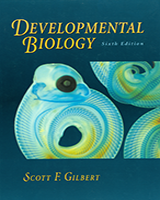By agreement with the publisher, this book is accessible by the search feature, but cannot be browsed.
NCBI Bookshelf. A service of the National Library of Medicine, National Institutes of Health.
Gilbert SF. Developmental Biology. 6th edition. Sunderland (MA): Sinauer Associates; 2000.

Developmental Biology. 6th edition.
Show detailsOf physiology from top to toe I sing, Not physiognomy alone or brain alone is worthy for the Muse, I say the form complete is worthier far, The Female equally with the Male I sing.
Walt Whitman (1867)*
The history of a man for the nine months preceding his birth would be far more interesting, and contain events of far greater moment, than all the three-score and ten years that follow it.
Samuel Taylor Coleridge (1885)**
- *
Whitman, W. 1867. “Inscriptions.” In Leaves of Grass and Selected Prose. S. Bradley (ed.), 1949. Holt, Rinehart & Winston, New York, p. 1.
- **
Coleridge, S. T. 1885. Miscellenea. Bohn, London, p. 301
In Chapters 12 and 13, we followed the various tissues formed by the vertebrate ectoderm. In this chapter and the next, we will follow the development of the mesodermal and endodermal germ layers. We will see that the endoderm forms the lining of the digestive and respiratory tubes, with their associated organs. The mesoderm will be seen to generate all the organs between the ectodermal wall and the endodermal tissues.
The mesoderm of a neurula-stage embryo can be divided into five regions (Figure 14.1). The first region is the chordamesoderm. This tissue forms the notochord, a transient organ whose major functions include inducing the formation of the neural tube and establishing the anterior-posterior body axis. (The formation of the notochord on the future dorsal side of the embryo was discussed in Chapters 10 and 11.) The second region is the paraxial mesoderm (or somitic dorsal mesoderm). The term dorsal refers to the observation that the tissues developing from this region will be in the back of the embryo, along the spine. The cells in this region will form somites, blocks of mesodermal cells on both sides of the neural tube that will produce many of the connective tissues of the back (bone, muscle, cartilage, and dermis). The third region, the intermediate mesoderm, forms the urogenital system. Farther away from the notochord, the lateral plate mesoderm gives rise to the heart, blood vessels, and blood cells of the circulatory system, as well as to the lining of the body cavities and to all the mesodermal components of the limbs except the muscles. It will also form a series of extraembryonic membranes that are important for transporting nutrients to the embryo. Finally, the head mesenchyme contributes to the connective tissues and musculature of the face.

Figure 14.1
The major lineages of the mesoderm.
Contents
- Paraxial Mesoderm: The Somites and Their Derivatives
- Myogenesis: The Development of Muscle
- Osteogenesis: The Development of Bones
- Intermediate Mesoderm
- Snapshot Summary: Paraxial and Intermediate Mesoderm
- References
- Paraxial and intermediate mesoderm - Developmental BiologyParaxial and intermediate mesoderm - Developmental Biology
Your browsing activity is empty.
Activity recording is turned off.
See more...